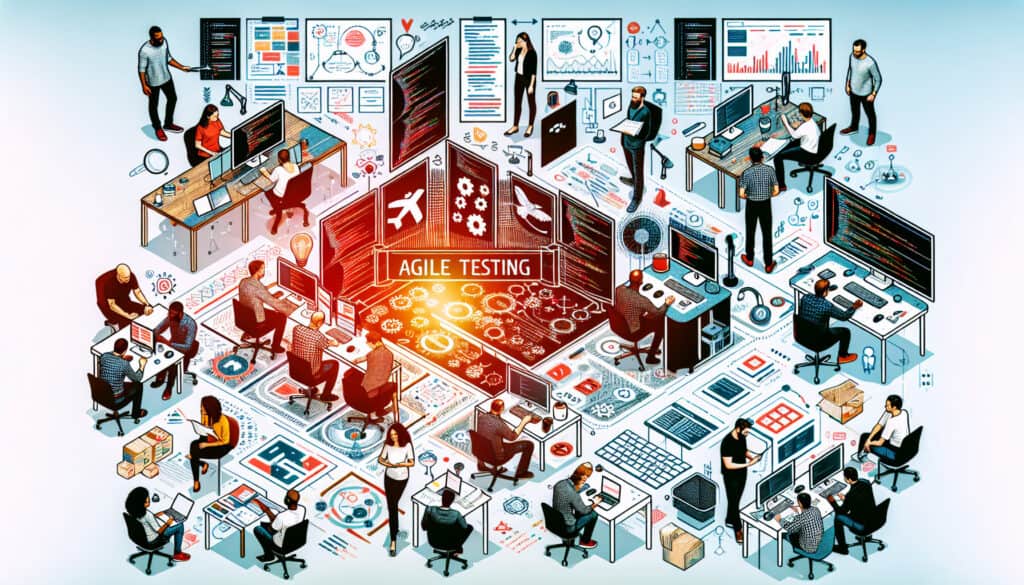A logiciel pratique de test qui suit les principes du développement agile de logiciels.
- Méthodologies : Clients et marketing, Économie, Conception de Produits
Tests agiles

Tests agiles
- Méthodologie Agile, Développement agile de produits, Amélioration continue, Assurance qualité, Contrôle de qualité, Gestion de la qualité, Scrum, Software Testing, Méthodes d'essai
Objectif :
Comment il est utilisé :
- Dans le cadre des tests agiles, les tests ne constituent pas une phase distincte, mais sont intégrés au processus de développement. Les testeurs travaillent en étroite collaboration avec les développeurs pour s'assurer que la qualité est intégrée au produit dès le départ.
Avantages
- Améliore la qualité des logiciels, réduit le risque de défauts et permet de livrer plus rapidement des logiciels fonctionnels.
Inconvénients
- Il peut être difficile à mettre en œuvre dans les équipes de test traditionnelles, il nécessite une étroite collaboration entre les testeurs et les développeurs et peut ne pas convenir à tous les types de projets.
Catégories :
- Conception de Produits, Gestion de projet, Qualité
Idéal pour :
- Assurer la qualité des logiciels dans un environnement de développement agile.
Les tests agiles sont particulièrement utiles dans les secteurs où l'évolution rapide des besoins exige une adaptabilité accrue, comme le développement de logiciels, le commerce électronique, les services financiers et les soins de santé. Dans ces secteurs, les tests agiles soutiennent les pratiques d'intégration et de déploiement continus (CI/CD), en veillant à ce que les tests soient effectués en même temps que le développement. Pendant les itérations ou les sprints, les équipes interfonctionnelles - y compris les développeurs, les testeurs et les propriétaires de produits - participent à des sessions de collaboration telles que la planification du sprint et les réunions quotidiennes, facilitant ainsi un retour d'information opportun et des améliorations itératives. Les méthodologies de test agiles englobent diverses techniques de test, notamment les tests unitaires, les tests d'intégration et les tests d'acceptation par l'utilisateur, qui permettent aux équipes de détecter les défauts à un stade précoce, lorsqu'il est moins coûteux de les corriger. Cette approche itérative minimise le risque de défaillances importantes en production, améliore la collaboration au sein de l'équipe et encourage une culture de la responsabilité. Des outils tels que les cadres de tests automatisés et les plateformes de tests continus sont couramment utilisés pour améliorer l'efficacité et fournir des boucles de retour d'information rapides. Les participants habituels à ce processus comprennent non seulement les testeurs et les développeurs, mais aussi les parties prenantes telles que les gestionnaires de produits et les analystes commerciaux, qui contribuent à la définition des critères d'acceptation et veillent à l'alignement sur les besoins des utilisateurs. Dans les contextes où l'expérience utilisateur est primordiale, comme le développement d'applications mobiles, les tests agiles permettent de s'assurer que les fonctionnalités sont non seulement fonctionnelles mais aussi conviviales et qu'elles répondent aux spécifications de conception prévues avant la mise en production.
Principales étapes de cette méthodologie
- Définir les critères d'acceptation en collaboration avec les parties prenantes.
- Impliquer les testeurs dans la planification du sprint pour comprendre les histoires des utilisateurs.
- Développer des tests automatisés parallèlement au code de l'application.
- Exécuter des tests en continu pendant le processus de développement.
- Intégrer les tests dans le pipeline d'intégration et de déploiement continus.
- Effectuer des tests exploratoires pendant les itérations pour obtenir un retour d'information immédiat.
- Procéder à des examens réguliers du code qui incluent des considérations relatives aux tests.
- Examiner et adapter les stratégies d'essai au cours des rétrospectives.
Conseils de pro
- Mettre en œuvre le développement piloté par le comportement (BDD) pour créer une compréhension commune parmi les membres de l'équipe, en améliorant la collaboration entre les testeurs et les développeurs.
- Utiliser des cadres de tests automatisés au début du sprint pour permettre une intégration continue et des boucles de retour d'information rapides sur les changements de code.
- Incorporer des sessions d'essais exploratoires aux essais scénarisés afin de découvrir les cas limites et d'améliorer la robustesse globale du produit.
Lire et comparer plusieurs méthodologies, nous recommandons le
> Référentiel méthodologique étendu <
ainsi que plus de 400 autres méthodologies.
Vos commentaires sur cette méthodologie ou des informations supplémentaires sont les bienvenus sur le site web de la Commission européenne. section des commentaires ci-dessous ↓ , ainsi que toute idée ou lien en rapport avec l'ingénierie.
Contexte historique
1828
1850
1854
1854
1911
1928
1950
1827
1848
1850
1854
1895
1914
1943
1970
(si la date est inconnue ou n'est pas pertinente, par exemple "mécanique des fluides", une estimation arrondie de son émergence notable est fournie)















Articles Similaires
Questionnaires sur les troubles musculo-squelettiques
Tests à plusieurs variables (MVT)
Analyse de régression multiple
Systèmes de capture de mouvement
Méthode MoSCoW
Test de la médiane de Mood